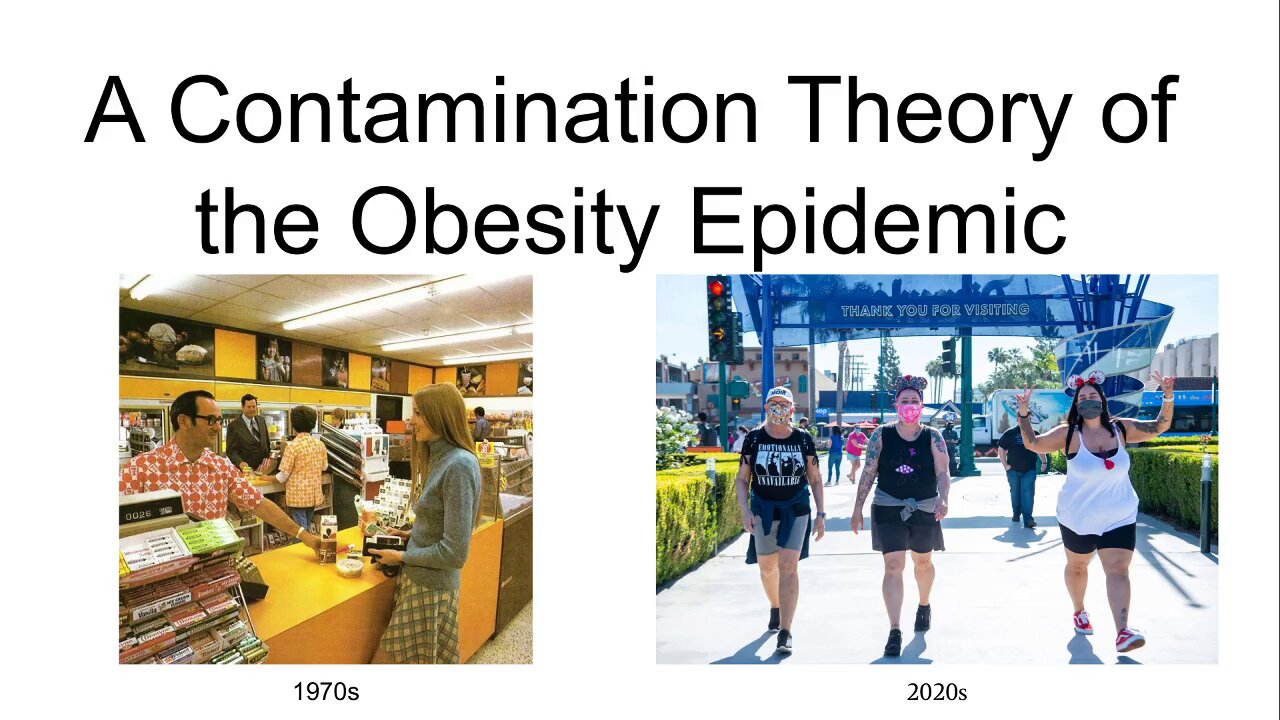Premium Only Content

A Contamination Theory of the Obesity Epidemic
Update 2022-02-09: I've updated my beliefs on contamination as a primary cause of the obesity epidemic. I think a better model is that our bodies have a set weight they try to maintain and will return to that point if we move very far from it. This is why people that lose weight often gain it back, and other people struggle to gain weight at all. The obesity epidemic is then the result of people's weight set points gradually moving up due to a breakdown in this self-regulation mechanism caused by easily accessible hyper-palatable non-satiating processed food and general poor health.
https://slatestarcodex.com/2017/04/25/book-review-the-hungry-brain/
In this video we will be discussing a contamination theory of the obesity epidemic, which is the theory that the large increase in obesity seen in the industrialized world since 1950 is largely caused by contaminants in our food and water.
There has been a very dramatic increase in obesity since the 1950s that has accelerated since 1970. In the 1800s the average U.S. man weighed 155lbs (70kg) while today in 2021 he weighs 195lbs (88kg). One possible explanation is that we evolved for an environment without widely available high calorie food, and now eat too much of them. However, in my opinion the evidence better supports contamination as a larger cause.
Modern hunter gatherers eat a wide range of diets, often without much variety, and consistently have healthy weights. Some eat large amounts of carbs, others proteins and fats, but they don’t have anywhere near the level of obesity seen in industrialized countries today. Additionally, immigrants to the United States from less industrialized countries generally have lower rates of obesity when they arrive, but become more obese while living in America. The obesity epidemic isn’t just in humans either, wild animals, lab animals, and zoo animals have all gotten fatter even under controlled lab or zoo conditions.
Obesity can be induced in lab rats by feeding them a diet of highly processed and palatable human food.
Notably higher altitudes are correlated with lower rates of obesity. One possible explanation for this correlation is that contaminants build up in the water supply as they flow downstream.
Comparing the rates of obesity geographically in the United States, obesity increases as you follow the Mississippi watershed from the mountains in Colorado, with one of the lowest obesity rates, to the Mississippi’s mouth in Louisiana, one of the most obese states in the nation.
Many believe that carbs or sugar cause obesity, however U.S. carbs and sugar intake have decreased since 2000 while obesity has continued to increase.
The question then is what contaminants could be causing this? There are a number of theories including Lithium, livestock antibiotics, PFAS chemicals in industrial use, Glyphosate in herbicides, or a combination of contaminants. We would expect the relevant contaminants to have increased since 1950, and dramatically increased since 1970. Lithium fits this description, and is known to cause obesity when ingested in sufficient quantity, but there isn’t conclusive evidence for any individual contaminant.
If this is true then what can be done? Since it isn’t known exactly what is causing the obesity epidemic it’s hard to say, but trying to reduce likely contaminants is probably a good strategy. Highly processed food is designed by food manufacturers to be addictive, causes obesity in lab rats, and potentially picks up more contamination with more processing. Replacing processed foods with unprocessed ones like potatoes, fruits, vegetables, and nuts would likely reduce contamination among other health benefits. Contaminants could also bioaccumulate in animals so eating less or higher quality meat may reduce contaminants, and vegetarians currently have lower obesity rates then the general public. Drinking distilled or purified water or getting water from a high elevation close to it’s source could reduce potential contaminants in drinking water. Finally, living in an area with a lower obesity rate could reduce contaminants and socially expose you to healthier habits.
For more information I recommend reading Slime Mold Time Mold’s writings on this subject, which curates the current research in a digestible format.
-
 LIVE
LIVE
SpartakusLIVE
3 hours agoFriday NITE HYPE
2,722 watching -
 LIVE
LIVE
Mally_Mouse
22 hours agoFriend Friday!! 🎉 - Let's Play! - Microworks
197 watching -
 LIVE
LIVE
Edge of Wonder
3 hours agoCattle Mutilations, Chupacabra Sightings & NASA’s Voyager Goes Dark?
151 watching -
 LIVE
LIVE
SavageJayGatsby
19 hours agoFriend Friday | MicroWorks | $300 Weekly Goal for Spicy Bite Saturday | 250 Follower Goal!
46 watching -
 LIVE
LIVE
Quite Frankly
2 days agoHookah Special: Found Footage, Workplace Folly, More Cringe Music Vids (8/23/25 Re-Run)
317 watching -
 12:38
12:38
AlaskanBallistics
18 hours agoNutrek Optics Coppertag 5-25x56mm Review
2.35K -
 LIVE
LIVE
The Mike Schwartz Show
4 hours agoTHE MIKE SCHWARTZ SHOW Evening Edition with Guests Dr. PETER MCCULLOUGH and JOHN LEAKE
4,218 watching -
 1:01:41
1:01:41
BonginoReport
9 hours agoAI & The Woke Indoctrination Ruining Childhood - Nightly Scroll w/ Hayley Caronia (Ep.123)
76.1K11 -
 1:17:29
1:17:29
Kim Iversen
5 hours agoTrotskyite Neocons: How MARXISTS Built the Modern GOP
70.7K101 -
 DVR
DVR
StoneMountain64
4 hours ago#1 Battlefield Mastery Session with the BOYS
19.9K1